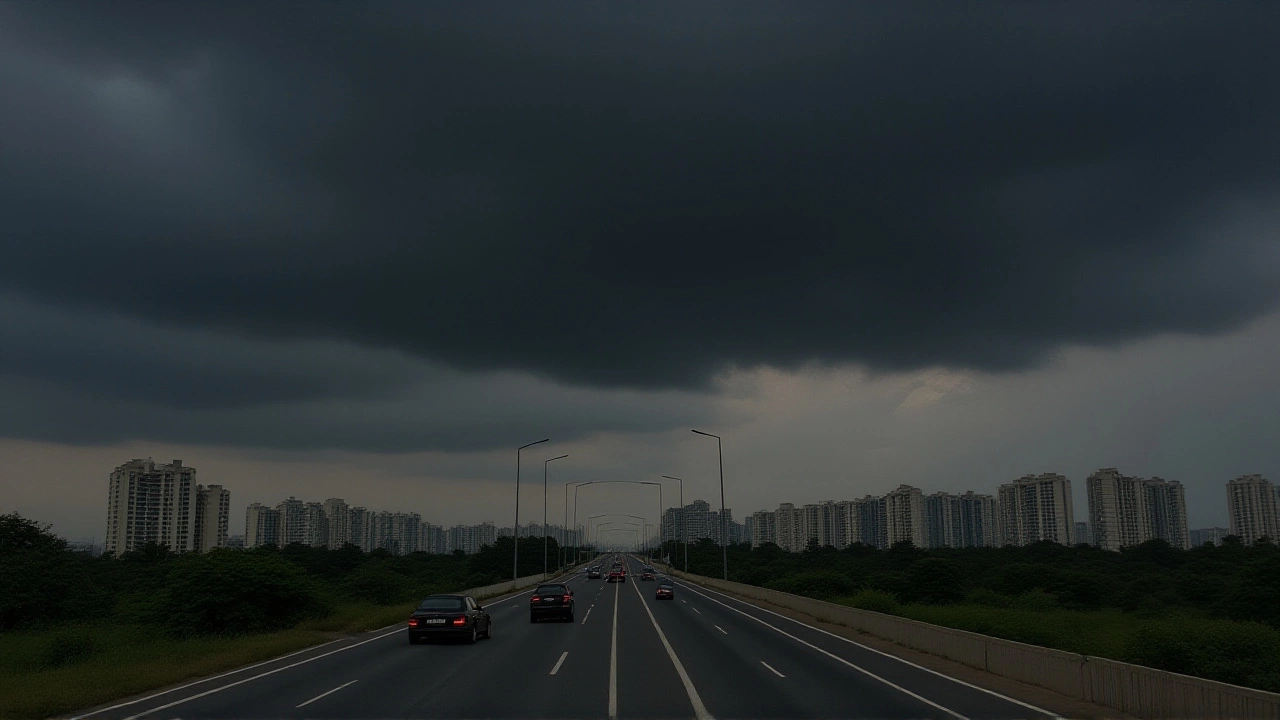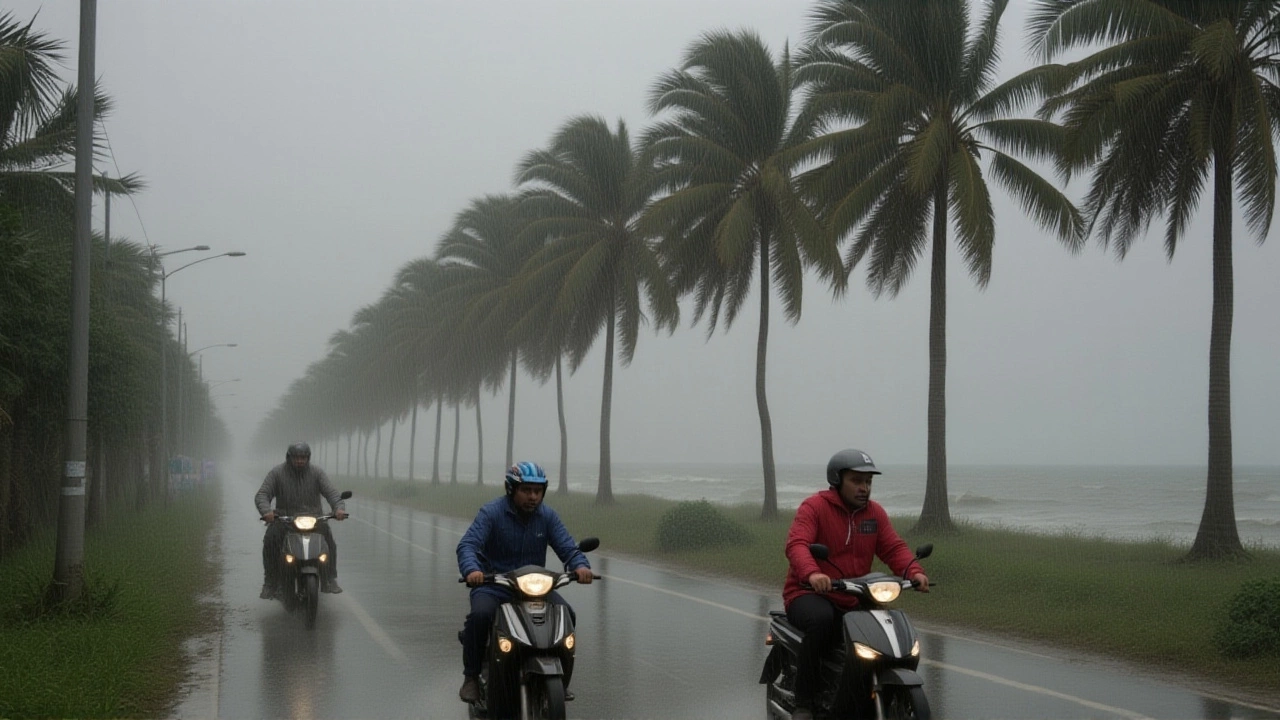21 Oct 2025
- 0 Comments
When Cyclone Fengal Bay of Bengal intensified into a cyclonic storm on November 29, 2024, the India Meteorological Department (IMD) sounded the alarm for the south‑coast states. By the early hours of Saturday, November 30, the system was rocking 3‑minute sustained winds of 85 km/h and a central pressure of 987 hPa, according to IMD’s bulletin. The Joint Typhoon Warning Center (JTWC) even nudged those numbers up to 95 km/h on a 1‑minute gust basis. What followed was a night‑time landfall near the Puducherry‑Marakkanam stretch, sandwiched between Karaikal and Mahabalipuram, that left schools shut, flights cancelled and streets flooded.
How Fengal Formed and Tracked
The newborn low emerged from a deep depression over the southwest Bay of Bengal on the afternoon of November 28. Within 24 hours, it gathered enough heat and moisture to earn the India Meteorological Department’s "cyclonic storm" label. Mritunjay Mohapatra, the department’s Director General of Meteorology, told reporters that sea‑surface temperatures above 30 °C and low vertical wind shear were the main drivers behind the rapid intensification.
As the storm tracked west‑northwest, the JTWC issued a series of advisories noting its unusually tight core. By 02:00 IST on November 30, Fengal was positioned about 120 km east of Cuddalore, poised to breach the Indian peninsula – a trajectory more common for cyclones that strike Odisha or West Bengal.
Instead, Fengal veered south‑west, hugging the coastline and making landfall just after sunset on November 30. The event marked a rare Bay of Bengal cyclone that managed to retain enough structure to re‑emerge over the Arabian Sea after crossing the peninsula – a feat last recorded with Cyclone Nilam in 2012.
Local Preparations and Immediate Impact
In anticipation of the onslaught, the IMD issued a red alert for Tamil Nadu, southern Andhra Pradesh, Kerala and Karnataka. The Union Territory of Puducherry responded swiftly: all schools in the district were closed until December 1, and officials warned fishermen to pull their boats ashore and seek higher ground.
At Chennai International Airport (IATA: MAA, ICAO: VOMM), air traffic controllers halted take‑offs and landings from 22:00 IST on November 30, only resuming normal operations in the early hours of December 1. The airport’s suspension affected roughly 7,800 passengers, many of whom were stranded overnight in hotel lobbies.
When the winds finally battered the coast, rain hammered the region at rates of up to 140 mm per hour in Cuddalore district. Residents in the towns of Villupuram and Kallakurichi reported water levels rising to shoulder height within three hours, flooding low‑lying homes and washing away roadways. In the Union Territory, the coastal stretch between Karaikal (10.05°N 79.82°E) and Mahabalipuram (12.52°N 80.00°E) saw the brunt of the surge, with several fishing villages reporting damage to boats and sheds.
Rescue Operations and Government Response
Mobilising under the Disaster Management Act of 2005, the National Disaster Response Force (NDRF) dispatched three teams – each equipped with 10‑person rapid‑deployment units – to the most vulnerable pockets of Tamil Nadu and Puducherry. Atul Karwal, the NDRF Director General, briefed the media that "our priority is to reach stranded families within the first six hours of the storm’s weakening, and to secure critical infrastructure like bridges and power substations."
The Tamil Nadu State Disaster Response Force, coordinated by Chief Minister M. K. Stalin, activated all 35 of its units. Over 2,400 volunteers from the Tamil Nadu Police and local NGOs joined the effort, distributing sandbags, dry rations and portable generators to the hardest‑hit villages.
By 11:30 IST on December 1, Fengal had weakened to a deep depression roughly 30 km north of Cuddalore. The NDRF reported rescuing 1,172 individuals from flooded homes, while the State Disaster Response Force cleared 84 km of stranded roadways, allowing relief trucks to reach remote hamlets.

Aftermath, Unusual Track, and Meteorological Significance
Even as the storm degraded, its remnants persisted. On December 3, the weakened low resurfaced over coastal Karnataka, brushing Udupi and Dakshina Kannada before sliding back into the Arabian Sea on December 4, where it finally dissipated. Meteorologists note that such a cross‑peninsula trek is rare; the interaction with the Western Ghats typically tears a cyclone apart.
Experts at the Indian Institute of Tropical Meteorology (IITM) in Pune highlighted that Fengal’s ability to retain a defined low‑level circulation across the Kaveri Delta was due to “persistent monsoonal moisture and a favorable upper‑level ridge that steered it away from the usual land‑locked decay path.” The event underscores growing challenges for disaster planners, who must now account for cyclones that can strike far‑off‑coast states and then re‑enter the ocean.
Financial damage estimates are still being compiled, but local officials suggest that agricultural loss alone could top ₹1.2 billion (≈ $15 million), primarily from submerged paddy fields and ruined horticulture in Cuddalore and Villupuram. Power outages affected roughly 450,000 households across Tamil Nadu and Puducherry, many of which remained without electricity for more than 48 hours.
What Lies Ahead – Preparing for the Next Season
With the 2024‑2025 cyclone season still months away, the IMD has already begun issuing pre‑season advisories. Mritunjay Mohapatra urged coastal administrations to upgrade early‑warning sirens and to conduct community drills before the onset of the pre‑monsoon surge in June.
Meanwhile, the NDRF is reviewing its deployment protocols to shrink response times in future cross‑peninsula events. The lessons from Fengal – especially the need for rapid inter‑state coordination – will likely shape policy discussions at the next meeting of the National Disaster Management Authority scheduled for early 2025.
Frequently Asked Questions
How many people were evacuated because of Cyclone Fengal?
Authorities report that roughly 1,200 residents were evacuated from low‑lying neighborhoods in Tamil Nadu and Puducherry, with the NDRF handling the majority of the rescues.
What made Fengal’s track unusual compared to typical Bay of Bengal cyclones?
Unlike most storms that hit Odisha or West Bengal, Fengal moved west‑southwest, striking the southern coast and then crossing the Indian peninsula, a route only seen in a handful of cases over the past three decades.
Which districts in Tamil Nadu suffered the most damage?
Cuddalore, Villupuram and Kallakurichi districts reported the highest flood levels, with many rice paddies submerged and road networks partially washed out.
What steps are being taken to improve early warnings for future cyclones?
The India Meteorological Department is upgrading its coastal radar network and launching mobile alert apps that push real‑time warnings directly to smartphones in vulnerable zones.
How did the cyclone affect air travel in the region?
Chennai International Airport suspended all flights from 22:00 IST on November 30 until the morning of December 1, delaying or canceling over 150 scheduled departures and arrivals.
